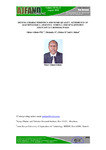Drying characteristics and some quality attributes of Rastrineobola argentea (Omena) and Stolephorus delicatulus (Kimarawali)

View/
Date
2010Author
Oduor-Odote, Peter
Shitanda, Douglas
Obiero M, M.
Kituu, G.
Metadata
Show full item recordAbstract
Rastrineobola argentea common name Omena and Stolephorus delicatulus common name Kimarawali are fishes that live in the freshwater and marine waters, respectively. Both are small in size, move in schools and are landed in large numbers during their peak landing seasons. Both go by the name Dagaa or sardines. In this study, they were dried in a locally fabricated solar tunnel dryer and on a drying rack in Gazi, South coast of Kenya for 14 hrs and their drying characteristics were evaluated using drying curves. Organoleptic analysis was carried out to compare some attributes of unsalted rack dried with salted spiced solar dried Kimarawali. The final moisture content of unsalted tunnel dried Kimarawali, unsalted rack dried Kimarwali, unsalted rack dried Omena and unsalted solar dried Omena was 0.161 kg/kg dry basis (db) (13.9% wet basis: wb), 0.163 kg/kg db (14.0% wb), 0.137 kg/kg db (12.7% wb) and 0.145 kg/kg db (12.1 wb)% respectively after 14 hrs of drying. The fish in the solar dryer attained moisture levels of 15% suitable for prevention of mould growth in 8 hours. The drying rate constants for unsalted tunnel dried and rack dried Omena were 0.23 and 0.22 with coefficient of determination (R2) values of 0.899 and 0.940, respectively. The corresponding drying rate constants for Kimarawali were 0.18 and 0.21 with coefficient of determination (R2) values of 0.814 and 0.932 respectively. There were no significant differences in drying rate after 14 hrs of drying for the two types of fishes and drying methods. The mean drying temperature for the tunnel dryer and drying rack during the 14 hrs of drying were 40.2±9.42 and 32.1±2.71 Celsius respectively. The corresponding relative humidity values were 53.7%±20.34 and 70.08%±2.72, respectively. There was no significant difference in the quality attributes between the tunnel and rack dried fishes. The score for overall acceptability was however higher for the spiced tunnel dried Kimarawali.
